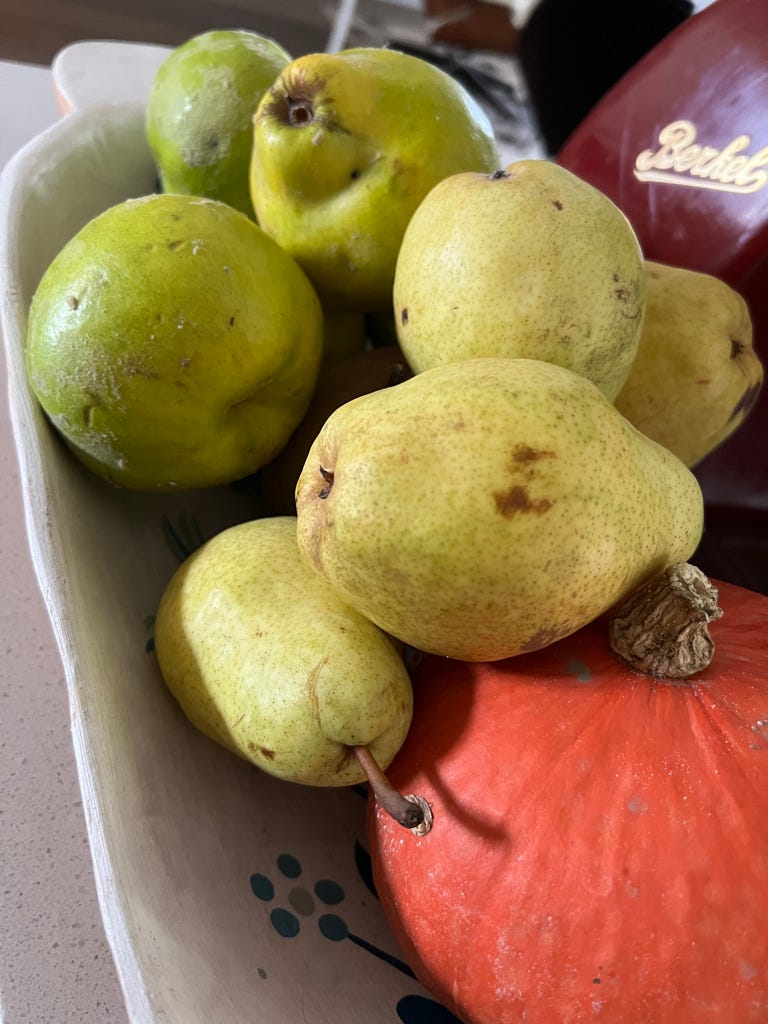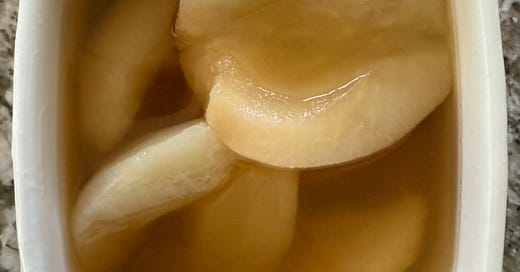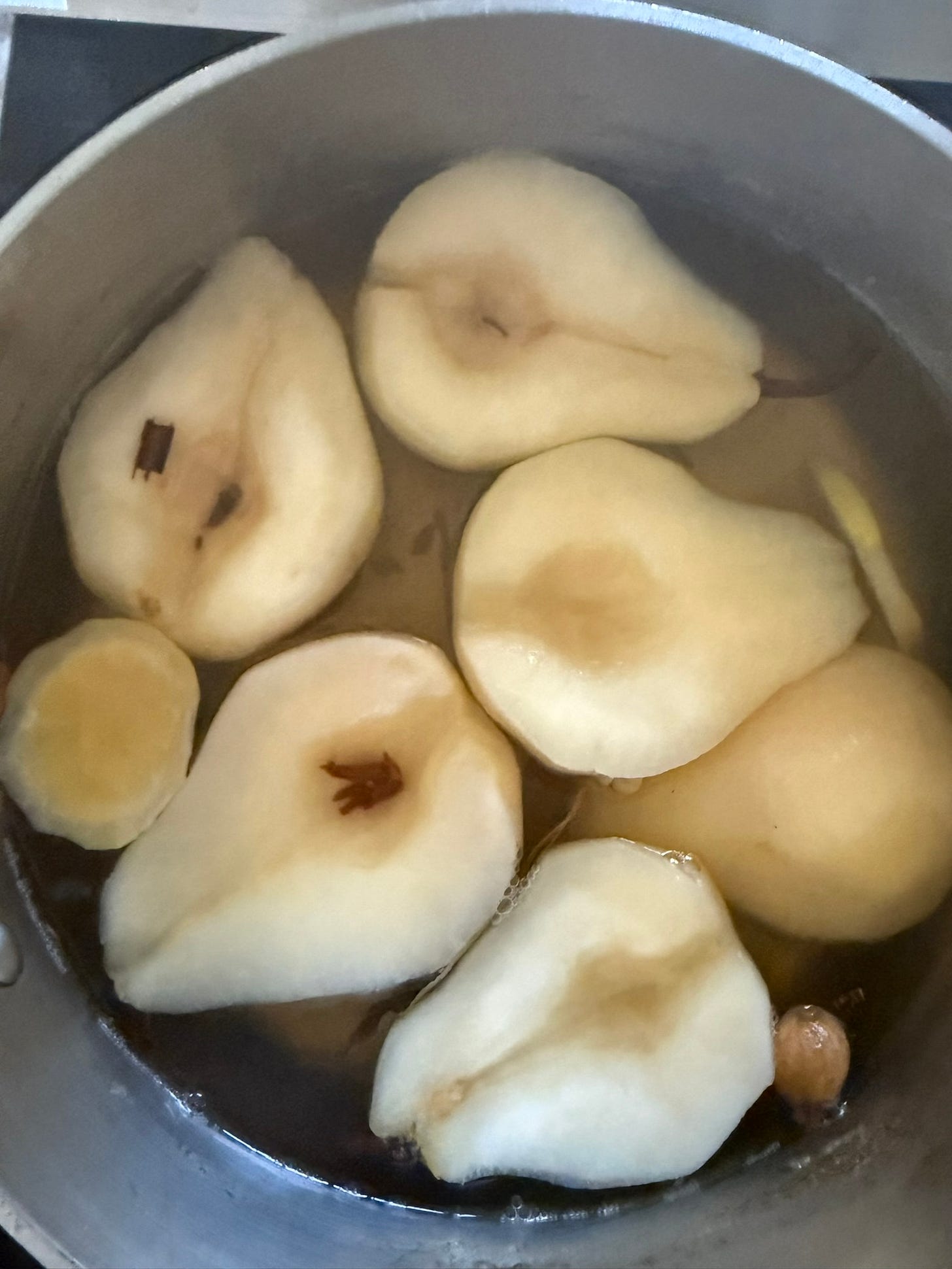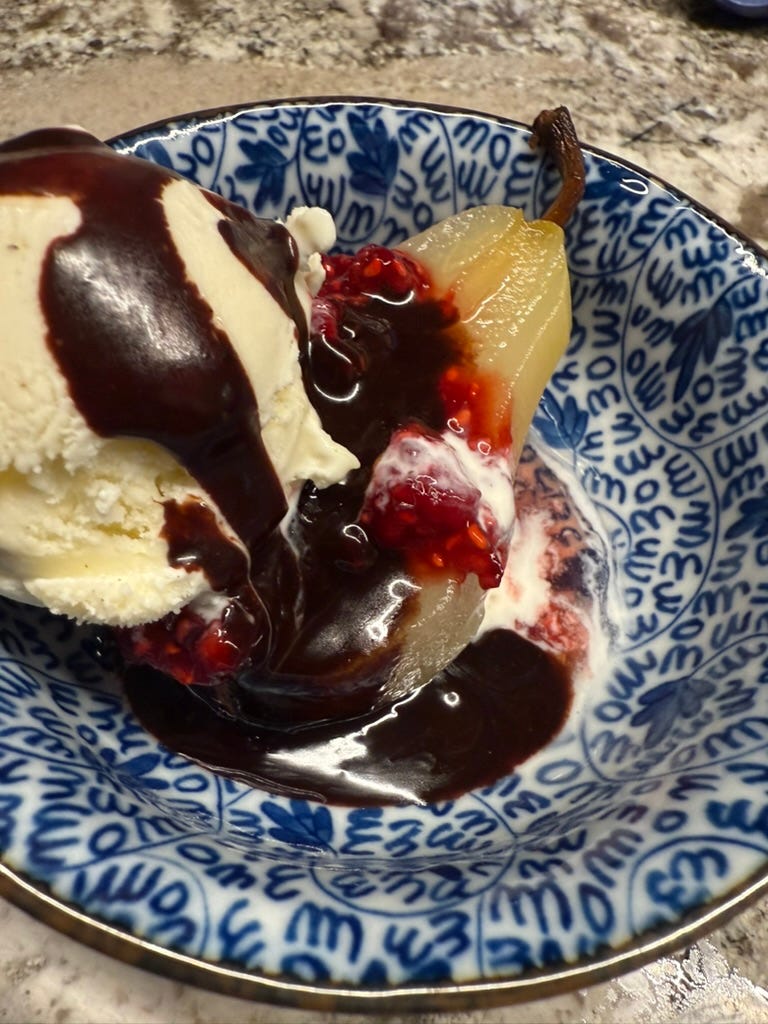If you were to buy a pear from a grocery store and bite into it on your way home, I’d understand why you might think you hate pears. Although we liken pears to apples, they are more like bananas or avocados, fruits that are shipped underripe and that need at least a few days to mature before they are eaten. A remarkable transformation happens on the counter as they become fragrant, juicy, and delicious.
Variety is important. My friend Ed Behr (Art of Eating) would say it accounts for up to 90% of the flavor of most fruit. I like Anjou and Bartlett pears. Comice can be good, too. I’m sure within these categories there must be hundreds of cultivars, but those are the only designations we get. A few weeks ago in a local grocery store I spotted an elongated pear with a crooked neck I recognized from markets in Italy and France. Known as Abbott pears or Abate Fetel, these pears, grown in Argentina, gave me a good feeling. Once ripe, they were sweet, had pleasingly dense flesh, and strong pear flavor.

If you’ve watched a pear ripen, you’d understand why they are sold before they reach their eat-me stage. The skin begins to blacken and blemish seemingly anywhere the fruit has been touched. Dents appear where there were none before. The silly produce identification sticker dares you to remove it. Like a band-aid, the adhesive inevitably tears off a piece of skin, leaving flesh exposed to oxidize.
What’s more, there’s really only a small window of time in which the pear is ideal for eating, a day or two at most, before the sweetness begins to ferment and the flesh turns to mush. It’s easy to miss it.
Occasionally a pear doesn’t give. I recently had a couple of Bartlett pears that sat on my counter for weeks. Nothing happened. I kept waiting for them to ripen or rot. One day I just cut into one, thinking that maybe it was deceptively juicy under a hardened exterior. It was crunchy, astringent, and unpleasant. Pears are not apples.
That’s when I decided to poach.
Unable to just throw those ripe-resistant pears away, I thought I could at least try to coax out their charms by poaching them. It worked.
Though poached pears are not that distant from their canned cousins, they nevertheless seem elegant, almost fancy, especially if you poach them in wine—continental, you might say. They don’t require much effort or skill, and they keep for some time in the fridge.
A poached pear with a dollop of yogurt or a scoop of vanilla ice cream is a dessert that’s easy enough for a weeknight meal, but fancy enough to serve to guests. Add chocolate or caramel sauce and its a celebration. Poached pears are delicious with pancakes, as noted by Nate last Monday morning. They can be used to make frangipane tarts or baked into galettes.

What’s more, the flavorful poaching syrup that remains once you remove the pears can be reused to poach more pears—I’m on my third batch since softening those Argentine rocks. The poaching liquid can also be used as a base for homemade drinks, soft or hard. And it can be strained and reduced to thicken to a syrup or sauce to accompany the pears themselves or other desserts or even pancakes.
I don’t adhere to a strict recipe, especially when it comes to the aromatics in the poaching liquid. A cinnamon stick, a few peppercorns, some allspice berries, a pinch of rose petals or lavender, a drizzle of honey, and a splash or more of wine. Mix it up.
French cooks lay a cartouche—that is, a circle of parchment with a hole cut out of the center to let the steam escape—on top of the simmering fruit to help keep it submerged while it cooks. I have a traditional Japanese otoshibuta, a cedar disk that serves the same purpose. You can also take your chances and forgo it. As the pears soften and swell they will sink.
RECIPE: Poached Pears
Serves 4
4 pears, Anjou, Bartlett, Comice or other variety, preferably not quite ripe, but on their way
4 cups water, or substitute up to 2 cups dry white or red wine
1 cup granulated sugar, or substitute up to 1/3 cup mild honey
4 strips lemon zest, made with a vegetable peeler
A combination of spices, such as 1 cinnamon stick, 6 black peppercorns, 1 bay leaf, 4 or 5 whole cloves and/or allspice or juniper berries, 1 or 2 whole star anise or slice(s) of dried licorice root, a couple of cracked cardamom pods, and/or a pinch of dried lavender or rose petals
2-inch piece of vanilla bean or 1 teaspoon vanilla paste or extract
Begin by preparing the pears. Cut each in half lengthwise. With the tip of a sharp paring knife, trace the central vein that leads from the stem, around the core and back up again to remove them. Some suggest using a melon baller to take out the core, though I’ve never done it. With the paring knife, carefully peel the pear half, doing your best to maintain its shape. Repeat until they are all ready.
In a medium saucepan over medium heat, combine the water, sugar, lemon zest, spices, and vanilla. Bring to a simmer and let cook to infuse for about 5 minutes. Place the pear halves into the simmering liquid. You can lay on a parchment cartouche (see above) to keep the pears submerged, or just set the lid ajar.
Cook the pears just until they begin to appear transparent and the tip of that same paring knife easily pokes into the flesh, 10 to 15 minutes for underripe pears. If your pears are very ripe, this may only take 5 minutes or so. If they are very hard, it will take longer, up to 25 minutes or more. Keep in mind that you are going to remove the pears from the heat and let them cool in the syrup so they will continue to cook further.
When cool, use a slotted spoon to transfer the pears to a storage container. Strain the poaching liquid over them (if you leave in the aromatics the flavors will become too strong). Save any liquid that doesn’t fit in the container in a jar for another use. The poached pears can be served warm or chilled.





